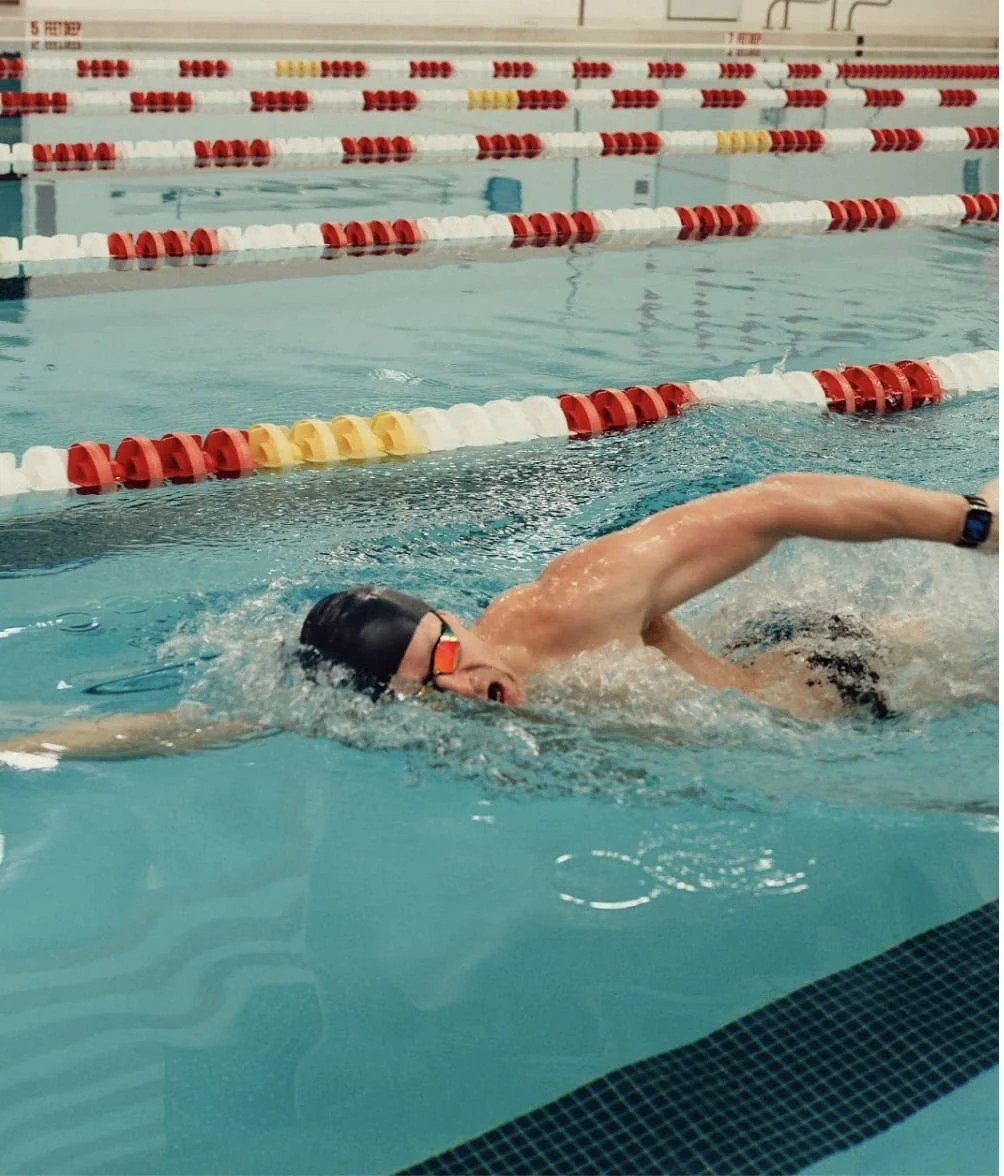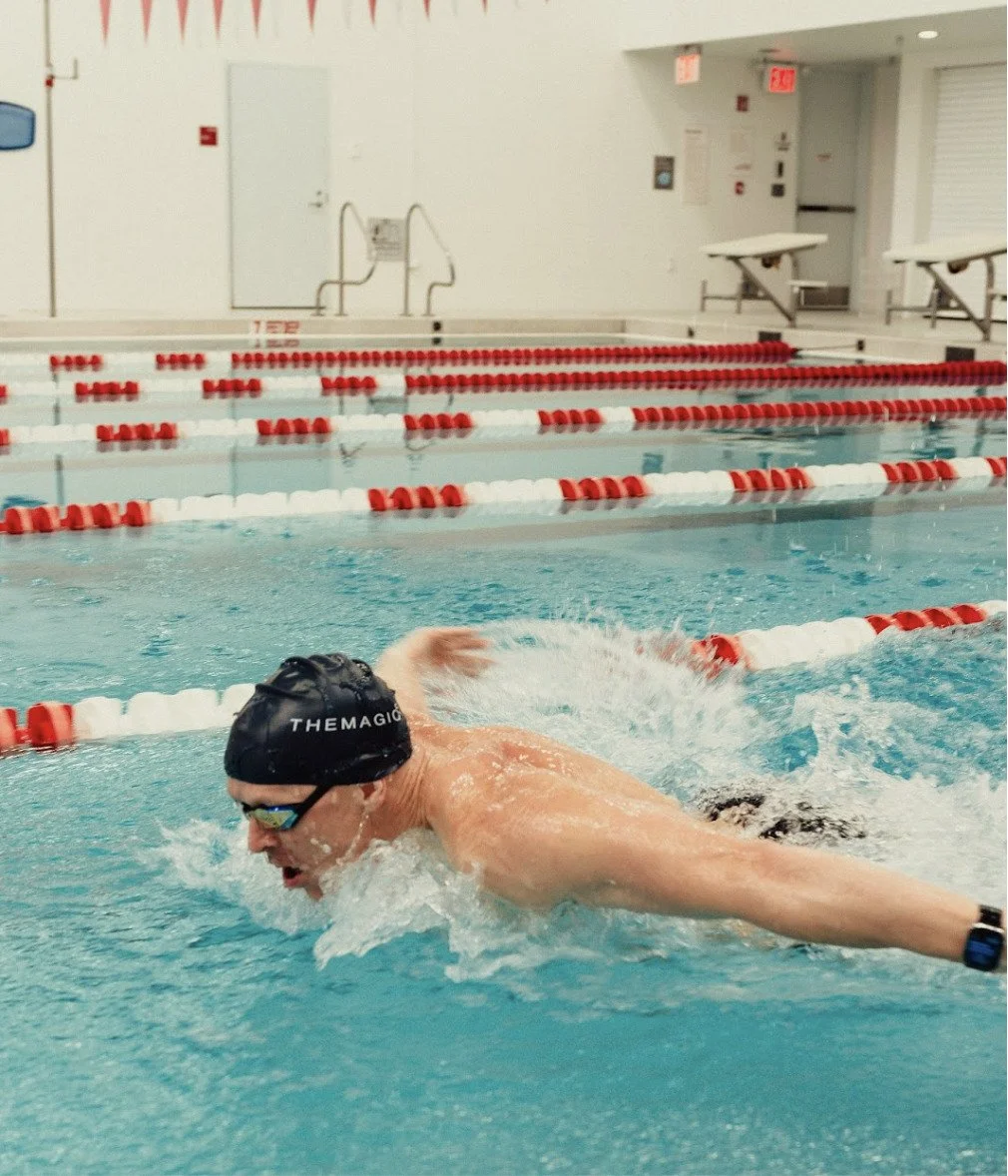What Muscles Does Swimming Work?
/When most people think about swimming, they picture gliding smoothly across the pool, counting laps, and building cardiovascular endurance. But what many don’t realize is just how many muscles are firing during those strokes. Swimming isn’t just cardio—it’s one of the most comprehensive strength and conditioning workouts available, and it challenges your body in a way few other activities can.
After more than two decades coaching swimmers, I’ve seen firsthand how understanding what muscles swimming works can change the way you train. It allows you to target weaknesses, sharpen technique, and prevent common injuries that hold swimmers back.
In this article, I’ll break down:
The major muscle groups used in swimming
Stroke-by-stroke muscle activation
Which muscles benefit the most
How to train these muscles on land and in the water
My goal is to give you a clear map of what’s happening beneath the surface—and how you can use this knowledge to swim stronger, faster, and more efficiently.
Swim Programs
Our swimming programs are designed to help you strengthen the muscles that matter most, refine your technique, and swim more efficiently with every stroke.
Why Swimming Is the Ultimate Full-Body Workout
Swimming is unique because of the environment: you’re working in a medium that provides constant resistance without the pounding of gravity. Every movement, whether it’s pulling, kicking, or stabilizing, has to overcome water resistance. That’s why swimmers develop not just cardiovascular fitness but also muscular strength and endurance.
Unlike running or cycling, which focus mainly on the lower body, swimming works muscles across the upper body, core, and lower body in one fluid sequence. The water demands balance, symmetry, and power all at once. That’s why even elite swimmers still rely on dryland strength training—it’s nearly impossible to fake strength imbalances in the pool.
The Major Muscle Groups Swimming Works
Before we dive into stroke-specific breakdowns, let’s look at the primary regions swimming engages.
1. Upper Body
This is where most of your propulsion comes from.
Latissimus dorsi (lats): The largest muscle in the upper body and the engine of your pull. These broad muscles dominate in the powerful strokes in freestyle, backstroke, and butterfly.
Pectorals (chest): Especially active in freestyle and breaststroke, helping push water back, and recover your arm overhead.
Deltoids (shoulders): Stabilize the recovery motion, crucial for recovery phases.
Rotator cuff: Small but critical—keeps the shoulder joint centered, providing a stable axis for the propulsive pulling muscle, while reducing injury.
Biceps & triceps: Assist with pulling (biceps) and pushing/extension (triceps).
2. Core
The unsung hero of swimming. Your core connects the upper and lower halves.
Rectus abdominis (abs): Keeps the body streamlined, reducing extension and uphill swimming posture, as well as powering dolphin kicks.
Obliques: Drive rotation in freestyle and backstroke.
Erector spinae (lower back): Maintain posture and streamline.
Deep stabilizers (transverse abdominis, multifidus): Provide stability for efficient force transfer, and protecting the spine.
Your core does more than support—it dictates how well you hold form and transfer power through every stroke.
Check out the guide: Best Core Workouts for Swimmers: Build a Stronger, Faster Body In and Out of the Pool
3. Lower Body
Legs are more than just propulsion—they also control body position.
Glutes: Essential for power in flutter and dolphin kicks.
Hamstrings: Assist in hip extension and lift during kicking.
Quadriceps: Fire hard during breaststroke whip kicks, and all stroke sprinting.
Hip flexors: Maintain flutter kick rhythm and streamline.
Calves: Keep toes pointed, improving hydrodynamics, as well powering start and turn jumping.
In short, swimming works every major muscle group. The beauty lies in how each stroke emphasizes different regions. For a detailed depiction of your anatomy in motion, grab a copy of Swimming Anatomy.
Swimming Anatomy - IAn MCLEOD
Stroke-by-Stroke: Muscles Worked in Swimming
Freestyle (Front Crawl)
Freestyle is often considered the foundation stroke. It’s fast, efficient, and trains nearly every muscle.
Upper body: Lats and pecs dominate the pull phase. Deltoids stabilize the shoulder as the arm recovers.
Core: Abs and obliques generate rotation, acting like a gearbox to transfer force.
Lower body: Hip flexors, quads, and calves maintain the flutter kick rhythm.
Coach’s Tip: If you want to swim freestyle faster, spend time on pull-ups and rotational core exercises. Stronger lats and obliques translate directly to more powerful upper body dominant strokes.
Breaststroke
Breaststroke feels different because of its symmetrical timing and glide.
Upper body: Pecs and biceps pull wide and recover under the body.
Core: Abs keep the torso tight during the glide phase.
Lower body: Inner thighs (adductors) and glutes power the whip kick, with quads giving the final push.
Coach’s Tip: Breaststroke is a leg-heavy stroke. Strengthen your inner thighs and hips with squat jumps and kettlebell swings to improve your kick efficiency.
Butterfly
Butterfly is the most physically demanding stroke—brutal but rewarding.
Upper body: Lats and deltoids do heavy lifting with each arm cycle.
Core: Abs and spinal erectors coordinate the undulating wave motion.
Lower body: Glutes and hamstrings generate propulsion during dolphin kicks.
Coach’s Tip: Butterfly is all about rhythm. Think of your core as the whip that drives both the arms and legs. A weak core makes butterfly almost impossible to sustain.
Butterfly is the most physically demanding stroke—brutal but rewarding.
Backstroke
Swimming on your back may feel easier, but the muscle demand remains high.
Upper body: Lats pull water; deltoids control recovery.
Core: Obliques and abs stabilize rotation.
Lower body: Hip flexors and quads maintain a steady flutter kick.
Coach’s Tip: Check out this drill series to refine hip extension and achieve a stronger backstroke body line: Backstroke Technique Drills
Ready to Master Your Backstroke?
Take your technique beyond the pool with the 12 Days to Better Backstroke Program — designed to improve your hip extension, body position, and overall stroke efficiency through swim-specific strength, mobility, and stability training.
You’ll get daily dryland sessions that directly translate to faster, smoother swimming — in just 10 minutes a day.
Beyond the Pool: Training Swimming Muscles on Land
Even with all the muscle engagement swimming provides, dryland training is essential. Here’s how I coach swimmers to complement pool work:
Strength Training
Pull-ups & lat pulldowns: Build lat strength for a stronger pull.
Push-ups & bench press: Develop chest and triceps for freestyle and breaststroke.
Squats & lunges: Strengthen quads, glutes, and hamstrings for kicking.
Planks & rotational core work: Train core for stability and rotation.
Mobility Work
Shoulder external rotation drills to balance strength and prevent injuries.
Hip mobility exercises for breaststroke efficiency.
Conditioning
Intervals: Sprint and recover to mimic race conditions.
Circuit training: Combine strength and aerobic work for swim-specific endurance.
Which Muscles Swimming Strengthens the Most
All strokes involve the whole body, but swimmers often see the greatest development in:
Lats and shoulders (freestyle, butterfly, backstroke)
Chest and triceps (breaststroke pull)
Adductors and quads (breaststroke kick)
Core stabilizers (across every stroke)
Shoulder stability is especially critical. Overdeveloped internal rotators without external balance can cause shoulder pain. Here’s a great breakdown from physiotherapist Daniel Moedas with the Portuguese national team: Shoulder Strength & Stability for Swimmers
Beyond the Pool: Training Swimming Muscles on Land
Even with all the muscle engagement swimming provides, dryland training is essential. Here’s how I coach swimmers to complement pool work:
Strength Training
Pull-ups & lat pulldowns: Build lat strength for a stronger pull.
Push-ups & bench press: Develop chest and triceps for freestyle and breaststroke.
Squats & lunges: Strengthen quads, glutes, and hamstrings for kicking.
Planks & rotational core work: Train core for stability and rotation.
Mobility Work
Shoulder external rotation drills to balance strength and prevent injuries.
Hip mobility exercises for breaststroke efficiency.
Conditioning
Intervals: Sprint and recover to mimic race conditions.
Circuit training: Combine strength and aerobic work for swim-specific endurance.
How to Maximize Swimming’s Muscle Benefits
To turn your pool time into real strength gains, focus on five key coaching principles. It all starts with fundamentals—excellence always lives there. Master your technique before adding more volume or intensity. Once the basics are solid, address your weak links. If your breaststroke kick feels sluggish, improve hip mobility and strengthen your adductors to unlock more power.
Vary your strokes to build balanced muscle development and reduce the risk of overuse injuries. Each stroke challenges your body in a unique way, helping you develop a better feel for the water. Support your swimming with smart dryland work, focusing on strength exercises that transfer directly to the pool. Finally, don’t overlook recovery—consistent sleep, proper nutrition, and mobility work keep your muscles performing at their best day after day.
Sample Swim + Dryland Combo
Here’s a simple session I give to competitive swimmers:
In the Pool:
8 x 50 freestyle pull with paddles (lat focus)
6 x 25 dolphin kicks with fins (glute and hamstring focus)
4 x 100 breaststroke kick with board (adductor emphasis)
On Land:
3 x 8 pull-ups
3 x 12 goblet squats
3 x 1-minute side planks with reach-through
This combination targets the exact muscles swimming uses while reinforcing strength outside the water.
Final Takeaway
Swimming isn’t just about endurance or technique—it’s a strength sport in disguise. Every stroke engages muscles across the shoulders, core, and legs, with each style putting unique demands on your body. By understanding the muscles worked in swimming, you can train smarter, prevent injuries, and unlock new levels of performance.
So, the next time you hit the water, remember: you’re not just logging laps—you’re training your entire body with every stroke.
And if you want structured dryland programming designed specifically for swimmers, I’d love to work with you. Together, we’ll strengthen the muscles that matter most and make your time in the pool more powerful than ever.
Ready to Get Stronger Outside the Pool?
Build the power, stability, and mobility that make every stroke more efficient.
Join our Monthly Dryland Subscription — a proven, swim-specific strength program designed to help you move better, recover faster, and swim stronger.






